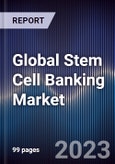The report provides a comprehensive analysis of the potential of Global Stem Cell Banking Market. The report covers an overview and genesis of the industry, market size in terms of revenue generated.
The report has market segmentation which include segments by source, by service type, by application, by cell type and by region; growth enablers and drivers; challenges and bottlenecks; trends driving adoption trends; regulatory framework; end-user analysis, industry analysis, competitive landscape including competition scenario and market shares of major players. The report concludes with future market projections of each market segmentation and analyst recommendations.
The report has market segmentation which include segments by source, by service type, by application, by cell type and by region; growth enablers and drivers; challenges and bottlenecks; trends driving adoption trends; regulatory framework; end-user analysis, industry analysis, competitive landscape including competition scenario and market shares of major players. The report concludes with future market projections of each market segmentation and analyst recommendations.
Market Overview:
According to publisher estimates, the Market Size of Global Stem Cell Banking has shown increasing trend from 2017 to 2022. However, due to COVID-19 restrictions and national & international guidelines, additional measures were taken to ensure secure stem cells collection from patients as well as donors, which resulted in decline in the overall stem cell banking market.- Placental stem cells are expected to dominate the global stem cell banking market by source due to high immune tolerance which make them a promising option for transplantation and other therapeutic applications
- The major market players are focusing on R&D activities to introduce new stem cell therapies in the market
Key Trends by Market Segment:
- By Source: Placental stem cells are a most common source of stem cells because they offer several advantages over other sources
- By Service Type: Sample collection and transportation is one of the most common types of services offered by stem cell banks because it is the first and most critical part of the process of preserving stem cells for future use
Future Outlook:
Market Size of Global Stem Cell Banking is expected to show increasing trend from 2022 to 2027. This is owing to increase in R&D due to therapeutic purpose, advancement in regenerative medicines, rising investment for stem cell therapy and banking and ability to test new drugs for safety and effectiveness.
Additional benefits of purchasing an enterprise license:
- TAM/SAM/SOM Analysis
- Customer Cohort Analysis
- Marketing Initiatives
- White Space Opportunity Analysis
- Interactive Data Visualizations
- Customization: 20 Analyst Hours
- 3 Months Post Sales Analyst Support
- Complimentary Update Next Year
- Custom Webinars
Table of Contents
1. Executive Summary
2. Global Stem Cell Banking Market Size and Segmentation, 2017-2022
3. Regional Analysis of North America Stem Cell Banking Market
4. Regional Analysis of Asia Pacific Stem Cell Banking Market
5. Regional Analysis of Europe Stem Cell Banking Market
6. Regional Analysis of LAMEA Stem Cell Banking Market
7. Competition/Industry Analysis of Stem Cell Banking Market
8. Company Profiles of Major Players in Stem Cell Banking Market
9. Future Outlook & Projections of Stem Cell Banking Market, 2022-2028
10. Analyst Recommendations
11. Research Methodology
Companies Mentioned (Partial List)
A selection of companies mentioned in this report includes, but is not limited to:
- CBR Systems
- CryoCell
- ViaCord
- Stemcyte Inc,
- Sartorius
- Smart Cells International Ltd.
- VITA 34
- Global Cord Blood Corporation
- Life Cell
- Cord Life








